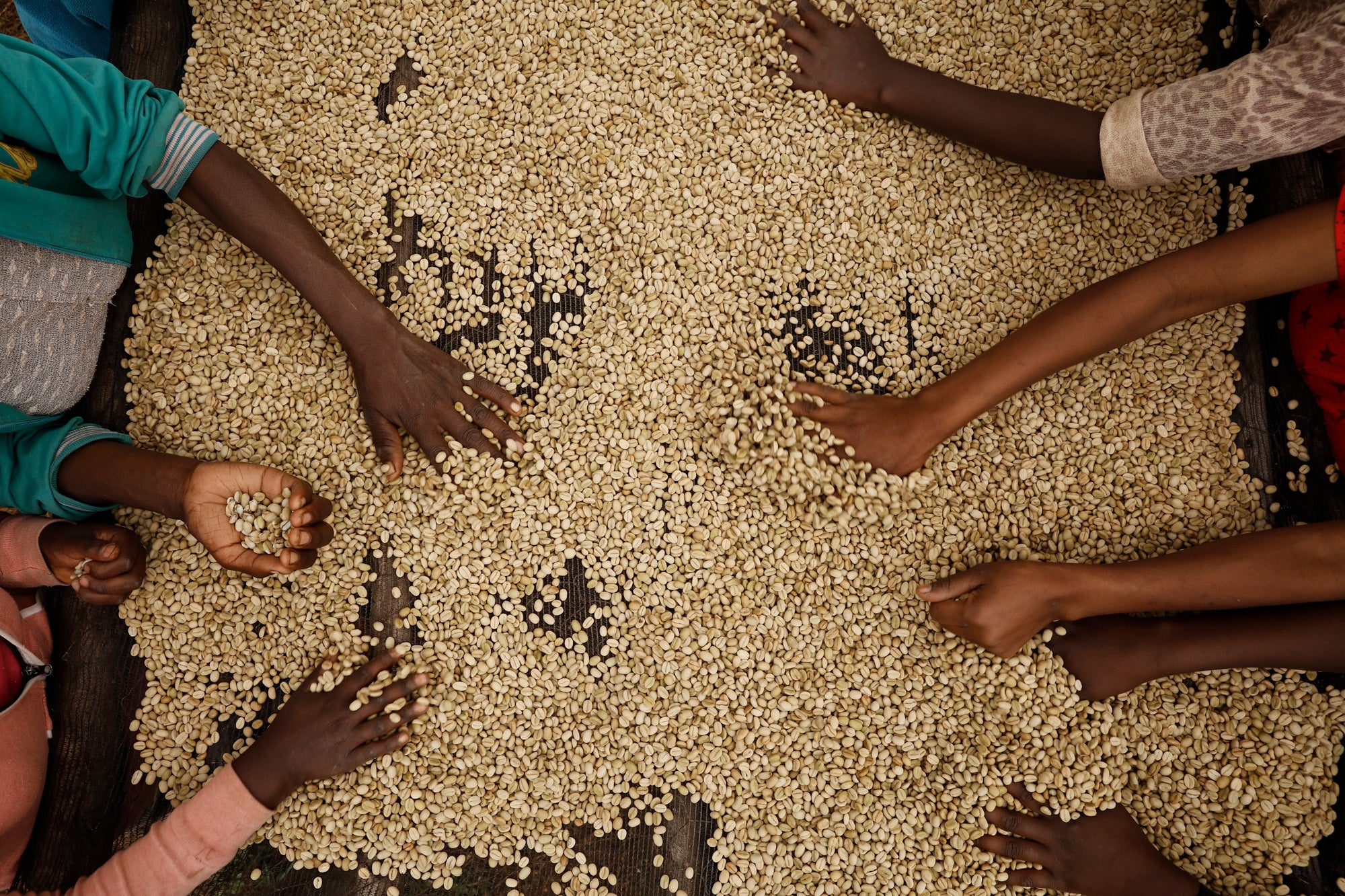Kamwangi
 Location: Gichugu division, Kirinyaga district, Kenya
Location: Gichugu division, Kirinyaga district, Kenya
Cooperative: New Ngariama Cooperative Society
Washing station: Kamwangi Factory
Elevation: 1600 - 1800 meters above sea level
Varietals: SL28, SL34, Ruiru 11
Bought since: 2011
This coffee is a familiar one for those of you who have been drinking Drop for years, and it is our favourite Kenyan coffee. Kamwangi is one of two factories run by the New Ngariama Cooperative in Kirinyaga in Central Kenya. The regions’ growing conditions and the many hours of sorting the coffee meticulously is the main reason Kamwangi has great quality and sparkling taste profile. The AA selection is the largest bean size of the harvest and gives the coffee a more pronounced and intensified flavour.
In Kenya, the process stations, or also called wet mills, are called factories. Kamwangi factory is one of two factories under the cooperative named New Ngariama Cooperative Society located in the region of Kirinyaga in the hills surrounding mount Kenya, with a third factory soon to become operational. This area is less known than its neighbour Nyeri but has surprised us from the beginning with some outstanding and memorable coffees.
The New Ngariama Cooperative Society is mainly made up of small farms, each with around 100 trees. In the Gichugu division of the Kirinyaga district where the surrounding farms to Kamwangi are located, the harvest starts in early November. The farmers are organized in Cooperative Societies that act as umbrella organizations for Kamwangi and their other cooperative, where the smallholders deliver their coffee cherries for processing freshly every day after picking in a period of about two months, normally delivering about 25-50 kilo by foot or bike for a few kilometres. When arriving at the factory, each producer will sort their cherries manually to separate defect and lower grade since they are paid more in relation to quality.
Part of what makes the Kenyan taste profile so unique is achieved through the highly controlled way it is sorted and processed. Rigorous sorting is done at each stage of the processing, creating an extremely consistent final product. Once the cherries are delivered to the factory and have been sorted for over and under ripe cherries, they are generally de-pulped directly by a large 4-disked pulper, which removes the cherry from the coffee bean.
This pulper also acts as the next stage of sorting, as the low density beans float to the top of water channels after the pulp is removed and are washed down into a separate fermentation tank from the denser, higher quality beans. Once they are de-pulped, they are fermented in large concrete tanks overnight, breaking down the sugary layer (mucilage) so that it may easily be removed during the washing process. Fermentation takes about 24-36 hours, depending on the temperature.
The factory manager checks if the coffee has finished fermented by rubbing it between their hands: if there is abrasion, then the mucilage has deteriorated sufficiently and the coffee may be washed further, along the line to the washing channels. If it is allowed to ferment further, the delicate flavour characteristics would be ruined so washing must occur at a very particular time in order to stop the fermentation process.
The coffee is washed in fresh water in order to remove the residual sugars of the mucilage and is then sorted by density. Lower density beans are once again separated to be sold as lower grade coffee whilst the higher density beans are held back by gates in the channels whilst workers sweep along the channels with paddles in order to move the coffee. Once the washing process is complete, the coffee is moved to drying beds in order to lower the moisture content to a stable level before storage.
During the warmest hours of the day the coffee is covered to protect the beans from too much sunshine (that can damage the beans) and to keep the drying time longer. If the drying beds are full, the higher grade coffee is often stored overnight in tanks of clean water to prevent any further fermentation whilst awaiting to be moved to the drying tables. On the drying tables the coffee is sorted and stirred by hand in order to ensure even drying, until the moisture content reaches 13% then it is moved to conditioned bins for storage where they lose about 1.5% more. The beans are graded after bean size where AA is screen 17/18. AB is screen 15/16 with a tolerance for 10% below screen 15.
The past few years Kenya’s coffee production has been struggling a lot with coffee berry disease (CBD) and tough weather conditions due to climate changes. This has led to more people planting the varietal Batian which is more resistant than SL28 and SL34 for example. However, the Batian plant is not always as high in acidity or as intense as the Kenyan coffee we have had the last decade that Kenyan coffee has been known for. The soil and the weather is changing due to climate changes
When visiting Kamwangi factory, the manager Edwin Gichori is quick to speak of the work being done at the factory in order to help raise quality levels and of where changes can be made in the long-term.
Kamwangi gives a small advance payment to the farmers at delivery. Some well-managed wet mills are able to give more than 85% of the sales price back to the farmers; Kamwangi is in general able to give back 80% after the cost of milling and marketing is deducted.
Registered in 1997, Kamwangi is Rainforest Alliance certified and have a good structure for tracking payments to producers. They also have established soaking pits for wastewater treatment as well as good quality control systems for processing.
Learn More
- Choosing a selection results in a full page refresh.
- Press the space key then arrow keys to make a selection.
